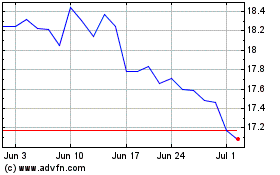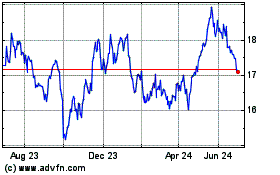Chapter 11 rules essentially put a lid on compensation to
California wildfire payouts
By Peg Brickley and Gretchen Morgenson | Photographs by Rachel Bujalski for The Wall Street Journal
This article is being republished as part of our daily
reproduction of WSJ.com articles that also appeared in the U.S.
print edition of The Wall Street Journal (November 9, 2019).
As many as 100,000 California residents who lost property, jobs
and loved ones in fires linked to PG&E Corp. will get their day
in court. It will be in bankruptcy court, where rules shield the
utility giant from potentially crippling jury payouts.
PG&E isn't broke. It is following the survival strategy used
by other troubled companies to put a lid on damage claims. For
victims, that amounts to a loss of negotiating power and likely
means a fraction of the compensation they might receive in a jury
trial.
California investigators have connected PG&E equipment to
fires that killed more than 100 people, destroyed 26,000 buildings
and burned at least 330,000 acres in 2017 and 2018. Lawyers for
fire victims estimate that the utility, which filed for chapter 11
bankruptcy protection in January, is liable for as much as $54
billion in wildfire claims.
Before filing, PG&E told investors its fire-related
liabilities could total more than $30 billion. The company is now
offering $20.4 billion to cover all damages, including
reimbursement to insurance companies. Of that, $7.5 billion is for
residents and business owners hurt by the fires.
Richard Kelly, then the company's chairman, said bankruptcy was
"the only viable option to address the company's responsibilities
to stakeholders."
PG&E's financial statements at the time it filed for
bankruptcy showed the utility was solvent, with assets exceeding
liabilities. The company's most recent annual report, filed in
February, showed nearly $77 billion in total assets, including
properties that could be used as collateral for loans -- enough to
cover $17.7 billion in debt and the $30 billion it estimated for
fire claims. PG&E says it will pay all it owes.
Bankruptcy rules are designed to give troubled companies a fresh
start by allowing them to negotiate with creditors rather than
answering to a jury. Wildfire victims are considered creditors owed
a debt by the utility.
Lawyers for PG&E and fire victims say there are between
70,000 and 100,000 people eligible to file wildfire claims against
the company. Other companies that have sought chapter 11 survived
waves of lawsuits filed by victims of asbestos and silicon breast
implants, among others.
The amount that fire victims are owed will be decided in a
proceeding known as an estimation. Only a handful of them will get
the chance to testify about their harm. Unless there is a
settlement, a federal judge will decide how much PG&E must set
aside for fire damage.
In the estimation hearings, lawyers for the utility will try to
reduce the compensation sum; lawyers for victims will seek more.
Another judge, who is overseeing the bankruptcy, will be asked to
approve a reorganization plan that frees the utility of
liability.
"I would love to get back what it's cost me," said Raymond
Rinaldi, a 78-year-old retired jockey whose home burned in 2017.
"But you know how it is when you fight these big companies --
they'll wait you out until you die."
Mr. Rinaldi estimates PG&E owes him roughly $200,000, the
amount he spent on the new mobile home he shares with his wife,
Betty Record, 83, in Marysville, Calif. His estimate is over and
above the $90,000 he received from the couple's homeowners
insurance.
PG&E said it was "committed to working with the remaining
individual plaintiffs to fairly and reasonably resolve their
claims." The utility has so far paid out $21 million through an
emergency fund to fire victims.
Mr. Rinaldi is among thousands of people yet to receive
compensation for the Cascade Fire sparked by PG&E equipment two
years ago. Those victims have been joined by tens of thousands of
others in the Camp Fire a year ago. State investigators determined
that it was started by a faulty PG&E transmission line. The
fire burned away the town of Paradise, Calif., in a matter of hours
last Nov. 8. Survivors marked the first anniversary Friday.
Possibly adding to its liabilities, PG&E disclosed that one
of its transmission lines failed in the area where the Kincade Fire
broke out last month in Sonoma County and burned more than 400
buildings.
Bankruptcy rules put victims of the Kincade Fire ahead of
others. By law, claims made after PG&E's January filing must be
fully paid on or before the day the utility exits bankruptcy.
Victims of the 2017 and 2018 fires may have to wait longer to
collect.
The utility's bankruptcy is complicated by a fight for control
of the company. PG&E and its shareholders are allied against
bondholders led by hedge fund Elliott Management Corp., which
alleges that the company is protecting shareholders at the expense
of fire victims and a safe operation.
The two sides have competing plans to settle claims, reorganize
PG&E and exit bankruptcy. Creditors will vote, and a bankruptcy
judge will decide.
Fire victims have agreed to back the bondholder plan, which
would pay them $13.5 billion, more than what PG&E offered. The
utility revealed Thursday that settlement talks could result in a
payout close to $13.5 billion.
California Gov. Gavin Newsom has urged the two sides to reach a
compromise that improves safety before the next fire season, and he
threatened a state takeover.
Todd Vincze, a 66-year-old former mechanic, is among those
waiting. A year ago, he escaped Paradise on a bicycle, leaving
behind his house, violins, guitars, guns, a Jaguar, a Lincoln and
all of his tools -- everything but his wallet and a leather jacket.
He figured his total loss was about $380,000.
As he awaits news about his PG&E and insurance claims,
living at a friend's place, Mr. Vincze drinks beer, he said, and
tries "to keep from going bats -- t crazy."
Escape route
When the Camp Fire engulfed Paradise, Calif., Bob Abercrombie
and his wife, June, fled with only the clothes they wore. The blaze
killed 85 people.
"I don't know if we should expect anything out of PG&E,"
said Mr. Abercrombie, an 85-year-old retired insurance agent who
nonetheless filed a claim.
He had insurance for his house and everything that burned
inside, but none for the couple's antique-car collection, which
included a 1929 Ford Model A.
State investigators have found that PG&E equipment caused
more than a dozen fires, including the Cascade Fire, which killed
four people and destroyed 264 structures in October 2017.
Faced with troubles of similar scale, dozens of companies have
filed for bankruptcy protection against an onslaught of damage
claims.
Dow Corning Corp. filed for chapter 11 in 1995 under a flood of
lawsuits for its silicone breast implants. It exited bankruptcy in
2004, after reaching a deal to pay $3.2 billion to 175,000 women.
W.R. Grace & Co. faced more than 129,000 lawsuits related to
its asbestos products. The company filed for chapter 11 in 2001,
and it emerged 13 years later with its equity intact and two trusts
for victims totaling $4 billion.
Like those companies, PG&E entered bankruptcy to settle
claims, Cecily Dumas, a lawyer for the committee representing fire
victims in the bankruptcy, told the court in May. What is
different, she said, is that "this debtor is still manufacturing
the dangerous product," referring to aged power lines.
Popular sentiment has turned against the company after
publicized safety lapses. Under the threat of wildfires this year,
the utility staged mass blackouts last month, pulling the plug on
millions of customers. The utility services 70,000 square miles in
Northern and Central California.
The utility last faced jurors in a criminal trial over the
explosion of a gas pipeline in San Bruno, Calif. The 2010 disaster
killed eight people and wrecked a neighborhood. After PG&E was
found guilty of violating federal safety rules, the judge ordered
the company to pay a $3 million fine and run TV ads publicizing the
felony conviction.
PG&E has since settled with plaintiffs in civil lawsuits,
often on the courthouse steps shortly before trials were set to
begin.
"They are terrified of seeing a jury," said Jared Ellias, a law
professor at the University of California's Hastings College of
Law. "It's difficult to overstate the antipathy toward PG&E
here. I can't imagine a less popular company."
A PG&E spokeswoman declined to comment on how the utility
views jury trials.
Making amends
U.S. Bankruptcy Judge Dennis Montali is presiding over the
utility's chapter 11 proceeding. To execute a final plan allowing
PG&E to exit bankruptcy, he first needs to know the extent of
its liabilities. So this summer he took the unusual step of
ordering a state trial to hear claims by victims of the 2017 Tubbs
Fire in Northern California's wine country.
State investigators had found PG&E likely wasn't the cause
of the fire, which killed 22 people and burned nearly 37,000 acres.
But lawyers for victims have argued otherwise, saying evidence has
surfaced that points responsibility to nearby PG&E power
lines.
If a jury finds the utility liable for the fire, PG&E would
add as much as $18 billion to what it owes, according to lawyers
for fire victims. After Judge Montali ordered the Tubbs Fire trial,
PG&E shares plunged 25%.
The trial, which is scheduled to begin Jan. 7 in San Francisco,
will be the only opportunity for fire victims to accuse PG&E of
wrongdoing before a jury. No matter how much money victims are
awarded in the case, however, they can collect only from the fund
PG&E sets aside for all fire victims in its bankruptcy
plan.
U.S. District Judge James Donato will calculate the final dollar
amount owed all victims in the estimation hearings, set to start
Feb. 18. His determination will be the sum PG&E must hold for
payment before it can exit bankruptcy. Arguments over ground rules
for the hearings have been heated.
Judge Donato last month criticized the way PG&E notified
fire victims about filing claims. At the time, only about half of
the 100,000 potentially eligible people had filed ahead of the Oct.
21 deadline.
"Maybe PG&E should have gone to each of the trailers"
provided by government emergency services and asked, "How do we
help you fill out your form?" the judge said. The utility has since
extended the deadline to Dec. 31.
Arriving at a figure for fire damages will involve weeks of
debate among experts on such matters as the cost a square foot to
replace homes destroyed, and the proper compensation for lives
lost.
Lawyers for fire victims say PG&E should pay punitive
damages because it knew its lines posed a public threat.
"PG&E strongly disagrees with the suggestion PG&E knew
of specific maintenance conditions that caused the Camp Fire and
nonetheless deferred work that would have addressed those
conditions," the PG&E spokeswoman said.
Victims also say PG&E should pay for emotional damage,
another decision for Judge Donato. The PG&E claim form asks
fire victims if they had been diagnosed with mental or emotional
injury as a result of the fires.
Lianna Price was 12 weeks pregnant when she and her husband
escaped Paradise with their three children, ages 5 and under. The
kids are still troubled by what happened.
"We drive somewhere, and there's a dust cloud, and they say,
'Mommy, is that a fire? Do we have to go?' " Ms. Price said.
--Elisa Cho and Jim Oberman contributed to this article.
Write to Peg Brickley at peg.brickley@wsj.com and Gretchen
Morgenson at gretchen.morgenson@wsj.com
(END) Dow Jones Newswires
November 09, 2019 02:47 ET (07:47 GMT)
Copyright (c) 2019 Dow Jones & Company, Inc.
PG&E (NYSE:PCG)
Historical Stock Chart
From Mar 2024 to Apr 2024

PG&E (NYSE:PCG)
Historical Stock Chart
From Apr 2023 to Apr 2024
